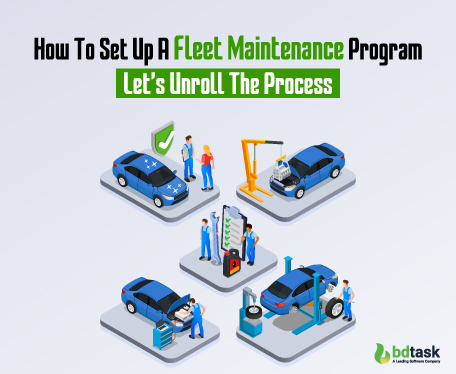How To Set Up A Fleet Maintenance Program - Guide To Follow
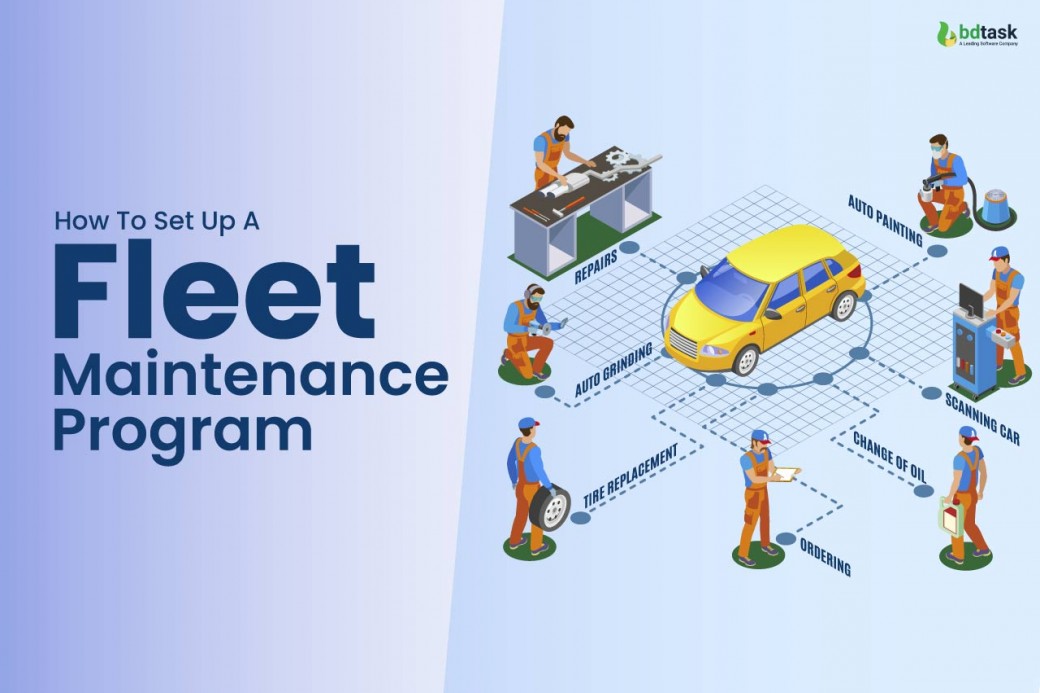
To maximise the availability of vehicles, you must know how to set up a fleet maintenance program. Every fleet has some goals and needs. As one of your fleet's top investments, each vehicle must be safe and sound. It also ensures the vehicle can stay on the road for the optimum amount of time.
In that sense, A proactive approach to a fleet maintenance programme is essential. The fleet preventive maintenance program is essential for fleets. Preventive maintenance can reduce long-term costs.
Fleet maintenance is the key to optimising the fleet.
Whether you're operating a small delivery fleet or managing a large-scale logistics network, the health of your vehicles directly impacts your bottom line.
The fleet preventive maintenance programme is the best way for the fleet to guarantee uptime and increase asset lifespan.
So, if you are a fleet owner or have many vehicles in your fleet, it's a must to learn how to set up a fleet maintenance program.
Let's learn how the fleet maintenance program is necessary for you and how to maintain the fleet program.
Let's discuss
Firstly, What Is Fleet Maintenance?
At the most basic,
The fleet maintenance program provides regular check-ups for your vehicle. It involves systematic inspections, repairs, and preventive measures to keep vehicles in top-notch condition.
Vehicles like to break down on us, which is a severe issue for a fleet manager. But with regular fleet maintenance, fleet maintenance plan, and ensuring that anything is possible. A fleet runs smoothly and, most importantly, cheaply; this all matters.
There are four essential action programs in any fleet maintenance. Each of these items ensures the success of the fleet maintenance program.
- Inspection
- Detection
- Correction
- Prevention
Why Is Fleet Maintenance So Important?
It is essential to run your fleet business smoothly. That's why you have an explicit knowledge of how to start a fleet business. If your fleet activities are not organised, then you face various issues. Failure to maintain your fleet properly impacts team downtime and overall safety.
When your vehicle is out of repair service, it also affects the productivity of your fleet business. The vehicle could break down in the middle of nowhere or have some tier issues because of non-regular maintenance.
Minimise cost and maximise profit
Below are just several potential side effects of not regularly fleet maintenance.
- The vehicle is not safe on the road.
- vehicles that are not maintained will cost more
- Unmaintained vehicles can increase your company's risk
Establishing a preventative maintenance schedule should be one of your top choices. Fleet maintenance programs bring many essential benefits that a business can realise.
- Extended vehicle life span
- Reduced liability
- Reduce the repair cost
Types Of Fleet Maintenance
A fleet manager must understand the different types of fleet maintenance plans. There are so many other ways to talk about how to keep your fleet in tip-top shape.
Fleet maintenance types stand as the foundation of successful companies and fleet operations. It's weaving together various threads contributing to their overall efficiency and reputation. Let's check some of the types of fleet maintenance programs.
1. Preventive Maintenance
Preventive maintenance is a type of maintenance that is performed regularly to prevent equipment failure.
It involves conducting
- Routine inspections
- Changing fluids and filters
- Replacing worn or damaged parts
2. Corrective Maintenance
Corrective maintenance is unscheduled maintenance work. It is following equipment failure to restore the system to the required performance levels.
It is usually more costly than preventive maintenance since it may involve replacing entire parts or systems.
The only difference between home appliance corrective maintenance and industrial corrective maintenance is that
- The latter may delve more deeply into investigating root causes
- Analysing overall fleet maintenance costs
- Reducing the likelihood of future equipment failure.
3. Predictive Maintenance
Addressing issues as they arise, corrective maintenance involves fixing problems after they are identified through inspections, testing, or reported by drivers.
4. Condition-Based Maintenance
Condition-based maintenance involves using different sensors and data to monitor vehicle performance. After that, this maintenance program finds out the potential issues. You must remember one thing: Maintenance will performed based on the vehicle's condition. This maintenance program operates at optimal levels.
Different Methods of Fleet Maintenance Program
Every fleet has unique goals and needs. To achieve this goal, you need to know different methods of car maintenance programs. The best vehicle maintenance programs and repairs can be performed using one of two methods. Let's discuss it shortly.
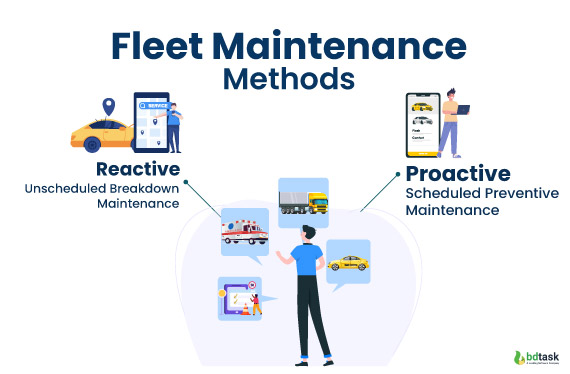
Vehicle maintenance programs and repairs can be performed in one of two methods:
Let's discuss it shortly.
1. Proactive: Scheduled Preventive Maintenance
Proactive maintenance means taking a proactive approach to your fleet. A solution to find the root cause of equipment failures before they cause more issues and lead to vehicle breakdowns.
Proactive maintenance can prevent
- Unexpected equipment downtime
- Increase equipment lifespan
- Save total maintenance costs
When to use a Proactive Method
Suppose you are from the Manufacturing, construction, and transportation industries. Then proactive methods are better suited to you, because of the value of their equipment and continuous operations.
Proactive maintenance can help prevent unexpected equipment breakdowns. It can increase equipment longevity, resulting in long-term cost savings.
2. Reactive: Unscheduled Breakdown Maintenance
Reactive maintenance is frequently more expensive than proactive maintenance. It is not recommended to use as a primary maintenance program. You can use this maintenance program when unexpected equipment problems occur. So how do you choose the best one for you? It depends on your business type.
When to use a Reactive Method
The reactive method is best for industries with less expensive equipment or with restricted funds. If you are not concerned about the proactive method, then it's for you. It only handles issues as they arise.
So it's up to you now. Choose the one. Before that, let's set up a fleet preventive maintenance program.
How To Set Up A Fleet Maintenance Program-Lets Unroll The Process
Every single day, a fleet maintenance manager follows and tracks a lot of things. A fleet manager has a lot of duties and responsibilities. Fleet maintenance is also a duty for him. But maintenance of their fleet organizedly is a challenging task.
That is why we are here to help. This is our step-by-step guide on how to set up a fleet maintenance program.
Let's follow the blog for the ultimate success and maximum ROI.
Define Your Fleet Maintenance Goals
1. Define Your Fleet Maintenance Goals -Start With The Basics
Before diving into the details, the first step is to outline your maintenance objectives. Identify key performance indicators (KPIs) such as
- Reducing downtime
- Extending vehicle lifespan
- Cutting repair costs.
This will clear the vision of your working plan and guide your fleet program's development work.
2. Create A Vehicle Inventory
Develop a detailed fleet inventory, including make, model, year, mileage, and maintenance history. This database will be the foundation for scheduling routine maintenance tasks and tracking the overall health of each vehicle. You should also consider some of the factors like the
- Demand for your services
- The lead time for ordering
- Receiving supplies
- The storage space and costs
- The risk of obsolescence or damage
A proper checklist can guarantee your vehicle inventory manager doesn’t miss any important data. An appropriate vehicle inventory helps boost your business productivity and enhance customer experience.
3. Build Up Maintenance Checklist
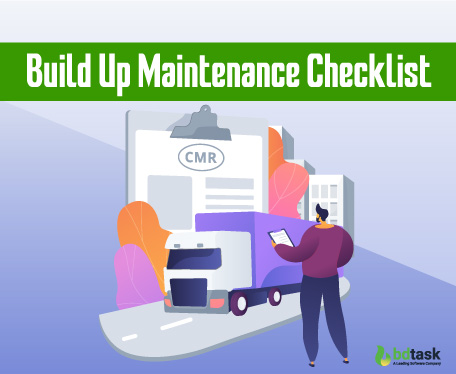
Maintained checklists are the critical tool to ensure your fleet vehicle is working correctly. A fleet maintenance schedule is essential in that sense. A maintenance checklist is mandatory if you want to meet your production goals and ensure customer satisfaction.
Well-designed preventive maintenance plans can boost up to 545% ROI. It means that every dollar spent on maintenance can save five dollars or more in the future.
Some maintenance checklist outline
- General tune-ups process
- Body check
- Monitoring electrical system components
- Check the brake system and replace the brake pads
- Check out the steering and suspension system
- Check the quality of tires, wheels, and rims
- Replacing tires on a timely basis
- Inspecting the exhaust system
- Evaluating the condition of the undercarriage and frame
- Interior and exterior lights check
- Changing engine oil and filters
- Transmission fluid out system
- cooling and fuel systems daily check
- Inspecting engine and transmission mounts
- Replacing the windshield wipers
- Inspecting seat structures and seatbelts
- Checking for fluid leaks
- Test backup systems
It mainly depends on the type of your vehicle. There are different types of vehicles in one fleet. So, some vehicles may require more robust inspections for compliance. You can manage the fleet maintenance schedule for each of the vehicles. You can follow a fleet maintenance schedule for your maintenance tracklist.
It is also essential to decide the frequency of the maintenance schedule for fleet vehicles and the inspection of equipment. Like daily, monthly, weekly and annually.
4. A Fleet Maintenance Management System -The Final Piece Of The Program
You can do all the fleet maintenance work manually, but the fleet maintenance system automates all the work. Utilise advanced fleet management software to streamline maintenance processes.
Generating all the reports manually takes too much time and is also not error-free.
Fleet maintenance solutions are the backbone of fleet maintenance companies.
The software also makes it simpler and more accessible for your fleet manager. He quickly reports on issues and submits required reports, such as essential inspections, after operating a vehicle.
Automated data collection reduces human error, boosting overall work speed and productivity.
These tools can automate scheduling, track maintenance histories, and provide real-time insights into the condition of your vehicles.
Look for some useful features, such as
- Fuel management
- Location detection through GPS
- Route planning and monitoring
- Vehicle maintenance program
- Driver behaviour
- Fleet alert system
- MYSQL database & many more
We are still going. Also, consider mobile capabilities and integrations with existing fleet management tools and cloud-based fleet solutions.
5. A Good Maintenance Budget
Outline a budget that covers routine maintenance, unexpected repairs, and replacement parts. a vehicle maintenance program is your saviour in reducing fleet maintenance costs. It will help you to get real-time data and time-to-time location updates.
Having a clear financial plan ensures that you can address maintenance needs promptly without compromising the overall health of your fleet.
6. Train Your Maintenance Team

How to set up a fleet maintenance program the very next step is to train the team very well.
Provide proper training to your maintenance staff. Equip them with the skills and knowledge needed to perform routine tasks and identify potential issues. Well-trained technicians contribute significantly to the success of your maintenance program.
7. Promote Driver Involvement
Engage your drivers in the maintenance process. Please encourage them to report any issues promptly and adhere to the prescribed maintenance schedule. A fleet maintenance policy is also important for fleet drivers.
A collaborative effort between drivers and fleet maintenance companies staff provides the overall effectiveness of the program. That's why a driver retention strategy is essential for your fleet maintenance program. Here are some of the tactics you can follow:
- A good idea to benchmark yourself against your competitors
- Communicate with your drivers
- Celebrate good driver performance
- Create a safe and reliable work environment
- Consider helping drivers prepare or pay for driving exams for different vehicles
8. Utilize Telematics for Monitoring
Technology can be a term card when it comes to creating a fleet maintenance program. Integrate telematics systems or vehicle management software to monitor vehicle performance in real time. These systems provide data on fuel efficiency, engine health, and driving behaviour. Utilising this information helps you identify issues early and optimise maintenance schedules.
9. Document and Analyze Maintenance Data
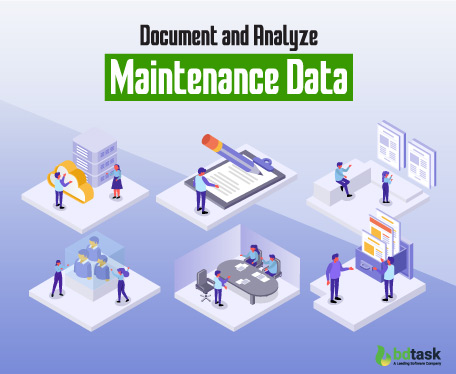
Keep detailed records of all maintenance activities. Regularly analyse this data to identify patterns, trends, and areas for improvement. Data-driven insights empower you to refine and optimise your truck Fleet Maintenance Program continuously.
Fleet maintenance staffing guides are critical components of the transportation and fleet logistics business.
End note
By following these steps, you can learn how to set up a fleet maintenance program. It reduces operational costs and provides your vehicle fleet's overall reliability and safety. Taking a proactive approach to maintenance will contribute to the long-term success of your fleet management strategy.
By implementing these strategies, your fleet can establish effective fleet maintenance services. As a result, that improves efficiency, extends the lifespan of their fleet, and generates business revenue.
